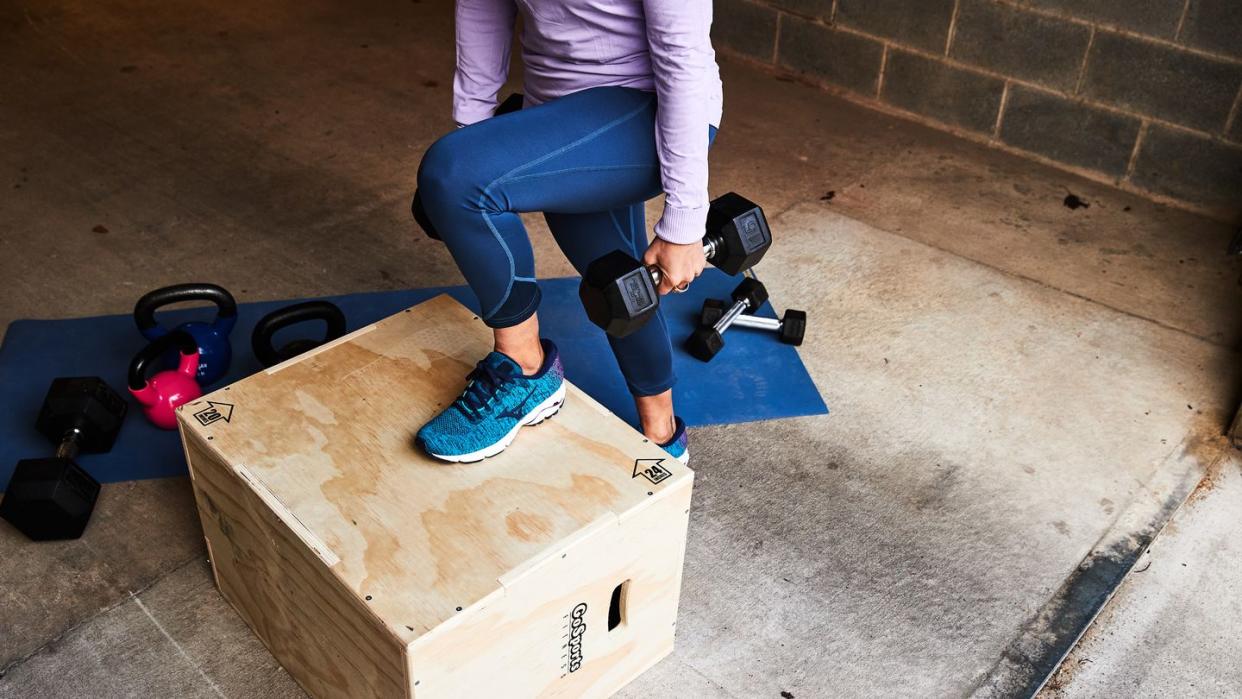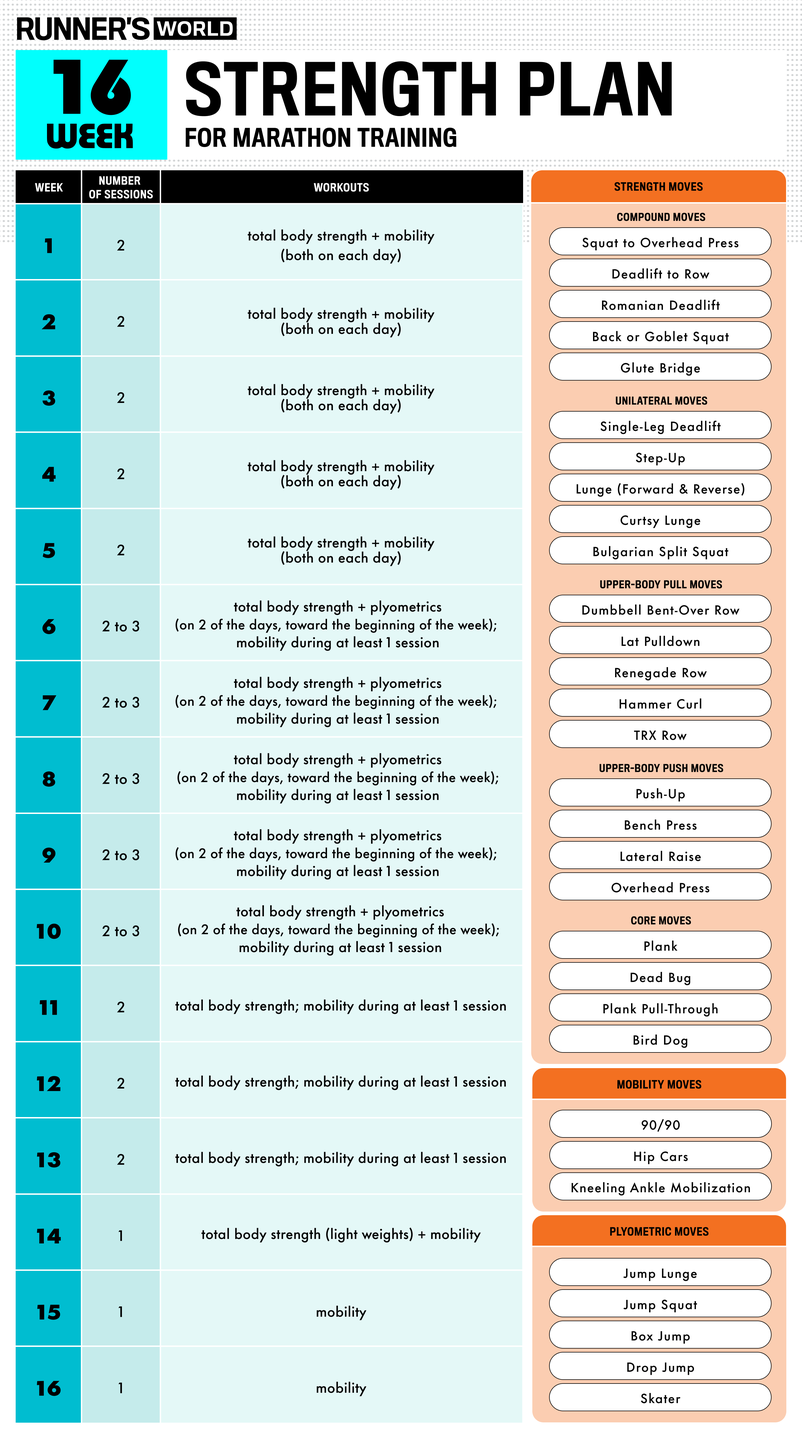Your 16-Week Marathon Strength Training Plan

"Hearst Magazines and Yahoo may earn commission or revenue on some items through these links."
[table-of-contents] stripped
Marathon training is no joke. From ramping up mileage over several weekday outings to spending multiple hours on your feet each weekend during a long training run, it can feel like all your free time is suddenly devoted to running.
So, it might seem challenging and/or virtually impossible to add even more training time to your schedule each week. But that’s exactly what you should do—by way of the weight room—if you want to get the most out of all the miles you’re covering.
“Marathon training can feel overwhelming, and fitting in strength training on top of your weekly runs can add to the overwhelm,” says Matt Jones, personal trainer, running coach, and founder of Run Strong Academy.
Working in resistance sessions, however, is super-important, he says. It can help minimize your chances of getting seriously hurt (by strengthening your joints and bone density and improving muscular imbalances, which could cause compensations in your gait) and help you bounce back from minor aches and pains. “More importantly,” he says, “it’ll help you enjoy running more because you’re going to be a more efficient—and less beat-up—runner.”
The science about whether lifting weights translates to fewer injuries is mixed. Long-distance runners who strength-trained the small accessory muscles around their feet had 2.42 times lower rate of running-related injuries compared with those who didn’t in a study published in the American Journal of Sports Medicine in 2020.
Another study, though, published in the journal Sports Health in 2020, followed runners prepping for the New York City Marathon and found that dropping out of the race due to an overuse injury happened to 7.1 percent of those who lifted weights versus 7.3 percent of runners who didn’t lift; so the injury-busting benefits were negligible.
That being said, there definitely is data to suggest that strength-training can make you a stronger runner. A meta-analysis published earlier this year found that strength training can improve running economy—or how well you use oxygen at a given speed, a measure of your efficiency. The researchers pointed to lifting heavy weights for lower reps and plyometrics as the stand-out types of strength training for improving performance.
Also, a middle- and long-distance runners who took up a strength-training routine (either heavy resistance, explosive resistance, or plyometrics) two to three times a week for at least four weeks improved their running economy, time trial performance, and anaerobic speed compared with people who only ran in a systematic review published in the journal Sports Medicine in 2017.
“Strength-training boosts your economy because the more power you have, the more distance you cover—in less time and with less energy,” says Meg Takacs, NASM-CPT, a run coach and founder of the Movement & Miles app.
Similarly, says Jones, your additional power from that time in the weight room (or home gym) can help enhance how long you can run comfortably. “You’re also going to have a stronger base to ‘spring’ from, which can help with power and endurance,” he says. “This in turn helps your ability to apply force to the ground—meaning every single stride you make is going to become more effective and more efficient.”
We tapped these two coaches for advice about how to approach resistance training throughout the marathon-training season so it will best complement your running. Keep reading for all the details, including ideas for moves to work into your routine and how to adjust your loads and reps each week for the biggest benefits.
How Your Marathon Strength Training Plan Breaks Down
Just as you don’t run the same number of miles or do the same types of workouts every week throughout your marathon-training cycle, you shouldn’t stick to the same strength moves and weights through those 16 weeks either. “As running mileage increases through your marathon training block, your strength focus should adjust to complement that,” says Jones.
Here’s how to adjust over those 16 weeks, broken into four blocks. Keep in mind that these workouts don’t have to cut a lot of time out of your day. Doing a handful of moves for just 20 to 30 minutes is all it takes, says Takacs.
Weeks 1–5: Build a Strength Base
For this plan, you’ll spend the first five or so weeks building your strength base. Aim for two strength workouts a week, each consisting of at least four to six exercises, suggests Jones; Takacs likes to do nine exercises (broken into three circuits of three moves each). Try to hit most major muscle groups in each session.
You can start with bodyweight moves, but work up to lifting heavier weights and lower reps (like five sets of five reps). Ideally, you’ll do your strength workouts on non-running days, says Jones, but it’s okay to tackle on the same day as a run if necessary for your schedule; just try to space out the two workouts by several hours.
Don’t do a strength session within 24 hours of a long run, says Jones, as it’ll leave your legs too wiped. “Side note: If you’re starting strength training for the first time,” he adds, “you’re more likely to accumulate fatigue—so don’t lift for 48 hours around the long run.”
During this block, you’ll also work on your mobility. “Runners often skip out on mobility, but if you want to progress to heavier weights and prevent restrictions in your range of motion, opening up your movement capacity is key to optimizing performance,” says Takacs. She advises concentrating on hip mobility specifically, as limited range of motion here can lead to compensations in gait (which could cause IT band syndrome and knee pain) and imbalances all the way down to your feet.
What to Do:
Week 1
2 sessions: total body strength + mobility (both on each day)
Week 2
2 sessions: total body strength + mobility (both on each day)
Week 3
2 sessions: total body strength + mobility (both on each day)
Week 4
2 sessions: total body strength + mobility (both on each day)
Week 5
2 sessions: total body strength + mobility (both on each day)
Weeks 6–10: Build Muscular Endurance and Power
The next five weeks feature higher reps (think three to four sets of eight to 12 reps) and slightly less load to improve your muscular endurance, plus plyometrics to enhance your force and stability, as well as runner-specific exercises (such as step-ups) and mobility at least once a week.
“This is the period where your body starts to respond to intentional, running-specific stimuli,” says Takacs. “The strength in these movements, and in this training period, translates directly to the efficiency of your running mechanics.”
As for the moves you choose, you can focus on lower body one workout and upper body/core the next or make every session total body. The latter is Jones’s preference, because, “that way, even if you can’t get a second or third session in one week, you’ll still be hitting every muscle group.”
Schedule strength workouts on the days that make the most sense for your schedule, says Jones, making sure to space them several hours from your runs (especially the long run—and especially if your legs are feeling heavy or tired). For the plyometrics, feel free to do them at the start of your strength workouts, he says, or before an easy run or speedwork as well.
What to Do:
Week 6
2 to 3 sessions: total body strength + plyometrics (on 2 of the days, toward the beginning of the week); mobility during at least 1 session
Week 7
2 to 3 sessions: total body strength + plyometrics (on 2 of the days, toward the beginning of the week); mobility during at least 1 session
Week 8
2 to 3 sessions: total body strength + plyometrics (on 2 of the days, toward the beginning of the week); mobility during at least 1 session
Week 9
2 to 3 sessions: total body strength + plyometrics (on 2 of the days, toward the beginning of the week); mobility during at least 1 session
Week 10
2 to 3 sessions: total body strength + plyometrics (on 2 of the days, toward the beginning of the week); mobility during at least 1 session
Weeks 11–13: Build Strength and Power
The third phase is a combo: Do lower reps/heavier weights (5 sets of 5 reps each) for compound movements (see: squats, deadlifts) which will help you build strength, and focus on higher reps/lower weights (3-4 sets of 8-12 reps) for unilateral and quick movements (such as jump lunges) to build stability and power. Plus, maintain a focus on mobility at least once a week.
Again, feel free to schedule strength workouts on the days that make the most sense for your schedule, ideally spacing them several hours from your runs (especially the long run—and especially if your legs are feeling heavy or tired). And do the breakdown that works best for you: total body in each strength session, or dividing it up between lower body and upper/core.
What to Do:
Week 11
2 sessions: total body strength; mobility during at least 1 session
Week 12
2 sessions: total body strength; mobility during at least 1 session
Week 13
2 sessions: total body strength; mobility during at least 1 session
Weeks 14-16: Taper Your Strength
Finally, just as you’re tapering your mileage during the last few weeks leading up to race day, you should pull back from strength moves, too. This time is for dialing back the intensity and “putting the focus back on recovery and maintenance,” says Takacs, who loves to zero in on mobility again during the taper. “Look at this period of strength training as less intense but still intentional to your specific body,” she says.
What to Do:
Week 14
1 session: total body strength (light weights) + mobility
Week 15
1 session: mobility
Week 16
1 session: mobility
Your 16-Week Strength Plan

The Best Strength Exercises to Do During Marathon Training
Aim for at least one exercise from each category during your total-body workouts. (If you need to break it up into workout splits, make sure you hit all major muscle groups each week.)
Compound Moves:
Squat to Overhead Press
Deadlift to Row
Back or Goblet Squat
Unilateral Moves
Step-Up
Reverse Step-Up
Lunge (Forward and Reverse)
Curtsy Lunge
Upper-Body Pull Moves:
Dumbbell Bent-Over Row
Lat Pulldown
Hammer Curl
TRX Row
Upper-Body Push Moves:
Bench Press
Lateral Raise
Overhead Press
Core Moves:
Mobility and Plyometric Moves to Add to Your Marathon Training
Focus on hip and ankle mobility in your workouts, aiming for 2- to 3-second holds and 5 to 10 reps of each move. For plyometrics, go for 8-10 reps or about 30 seconds each move.
Mobility
90/90
Cossack Squat
Plyometrics
Jump Lunge
Drop Jump
Skater
You Might Also Like

